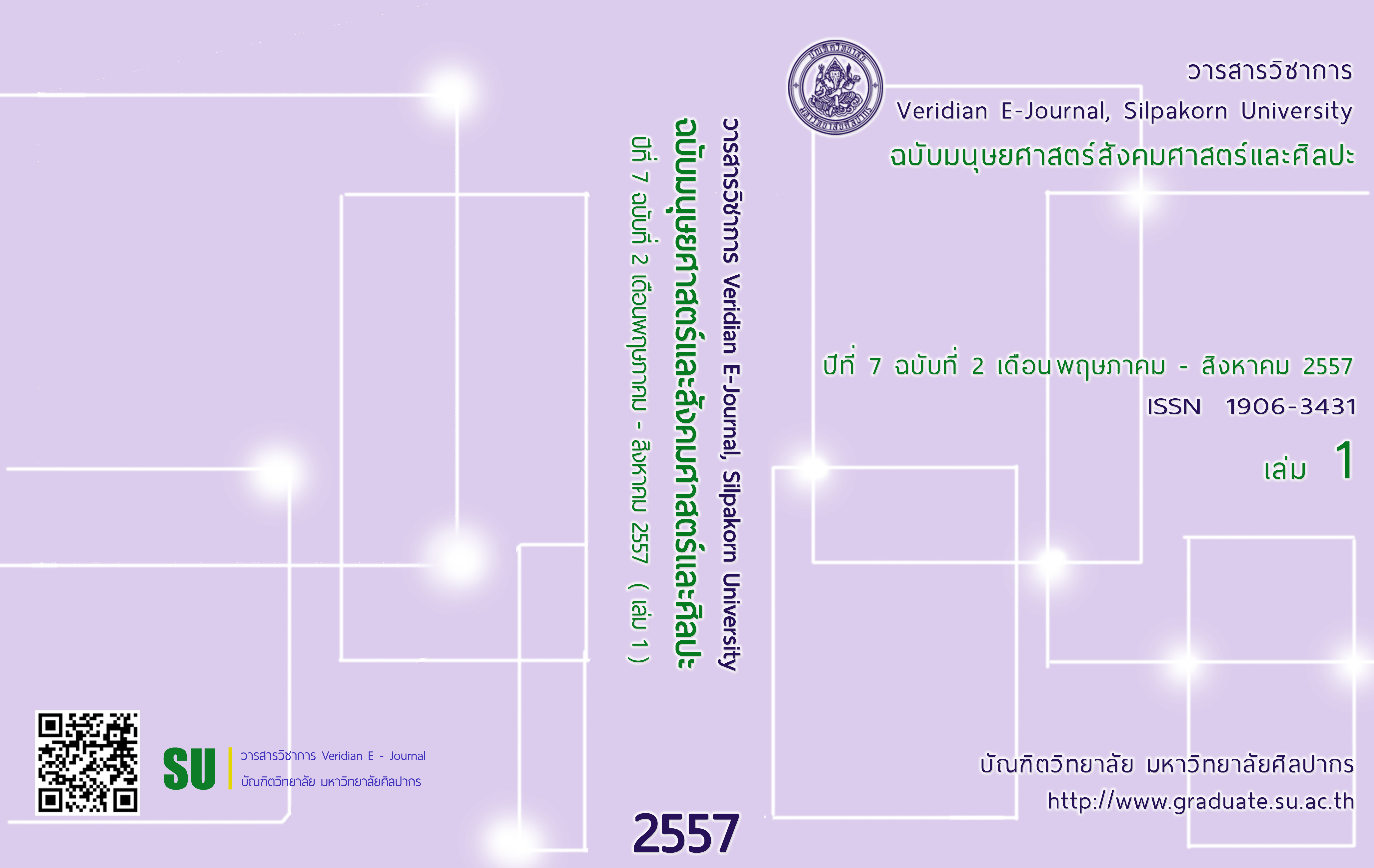การจัดการเส้นทางจักรยานเพื่อการท่องเที่ยวยั่งยืนในพื้นที่เขตตลิ่งชัน กรุงเทพมหานคร Bicycle route for sustainable tourism management in Taling-chan area, Bangkok
Main Article Content
Abstract
การศึกษาครั้งนี้มีวัตถุประสงค์เพื่อศึกษาทรัพยากรวัฒนธรรมและการท่องเที่ยวจักรยานในพื้นที่เขตตลิ่งชัน โดยใช้วิธีการศึกจากเอกสาร จากการลงพื้นที่และแบบสอบถาม นำผลที่ได้มาประเมินคุณค่าและวิเคราะห์จุดแข็ง จุดอ่อน โอกาสและอุปสรรคและนำเสนอเป็นเส้นทางจักรยานเพื่อการท่องเที่ยวและการจัดการเส้นทางจักรยานเพื่อการท่องเที่ยวยั่งยืน ภายใต้กรอบแนวคิดการจัดการทรัพยากรวัฒนธรรม การจัดการท่องเที่ยวยั่งยืนและการจัดการเส้นทางจักรยานเพื่อการท่องเที่ยว
ผลการศึกษาพบว่า พื้นที่เขตตลิ่งชันเป็นพื้นที่ที่มีประวัติศาสตร์และพัฒนาการมาอย่างต่อเนื่องตั้งแต่สมัยกรุงศรีอยุธยาจนถึงปัจจุบันและมีทรัพยากรวัฒนธรรมที่หลากหลาย ทั้งทรัพยากรวัฒนธรรมประเภทวัด ตลาดน้ำ ชุมชนชาวสวนและพิพิธภัณฑ์ที่มีคุณค่าทั้งทางด้านประวัติศาสตร์ ศิลปะหรือเทคนิค จิตวิญญาณ(ความเชื่อ/ความศรัทธา) และคุณค่าต่อวิถีชีวิตชุมชน มีศักยภาพทางด้านการท่องเที่ยวสูง จากการสำรวจเส้นทางและการศึกษาการท่องเที่ยวโดยจักรยานในพื้นที่เขตตลิ่งชันพบว่ามีเส้นทางคอนกรีตเสริมเหล็กกว้างประมาณ แต่ยังไม่ได้รับการส่งเสริมทั้งๆที่ย่านเป็นพื้นที่ที่มีความปลอดภัยสูง สามารถเข้าถึงวิถีชีวิตวัฒนธรรมชาวสวนได้เป็นอย่างดี ดังนั้นพื้นที่นี้จึงมีความเหมาะสมที่จะนำมาพัฒนาส่งเสริมให้เป็นเส้นทางจักรยานเพื่อการท่องเที่ยวได้ แต่มีปัญหาคือการท่องเที่ยวที่มีอยู่เดิมมีการใช้ทรัพยากรวัฒนธรรมและประชาสัมพันธ์ไม่ทั่วถึง ดังนั้นต้องศึกษาการจัดการเส้นทางจักรยานเพื่อการท่องเที่ยวโดยการให้ความสำคัญกับการใช้ทรัพยากรวัฒนธรรมในพื้นที่ให้ทั่วถึง โดยใช้ตลาดน้ำตลิ่งชัน ตลาดน้ำคลองลัดมะยม ตลาดน้ำวัดสะพาน ตลาดน้ำวัดตลิ่งชันและชุมชนชาวสวนย่านวัดจำปาเป็นศูนย์กลางให้การบริการท่องเที่ยวด้วยจักรยานเนื่องจากเป็นทรัพยากรการท่องเที่ยวที่อยู่ใกล้ชิดทรัพยากรวัฒนธรรม และมีความพร้อมทั้งทางด้านบุคลากรและศักยภาพทางด้านการท่องเที่ยวอยู่แล้ว หากแต่ต้องมีการจัดการแบบมีส่วนร่วมของทุกภาคส่วนและพัฒนาสิ่งอำนวยความสะดวกและการประชาสัมพันธ์เพื่อการท่องเที่ยวที่ดี
This research aimed to study about cultural resources and bicycle tour in Taling-chan area, Bangkok for planning bicycle routes for tourism and managing those bicycle routes to be a sustainable tourism. Document study, field study, and questionnaire were used for collecting data about cultural resources and bicycle tour. The data was analyzed to find out the information about cultural resources and bicycle tour in Taling-chan area for measuring value and investigating SWOT; strengths, weaknesses, opportunities, and threats. The information about culture and SWOT were employed in bicycle routes for tourism planning and bicycle routes for tourism setting based on cultural management framework, sustainable management, and bicycle routes management for tourism. The results of this study showed that Taling-chan area had history behind and it had been developed from Ayutthaya period until the present. Moreover, there were various kinds of cultural resources such as temples, floating markets, the museums and the simple-way of life of the community what carrying the historical value, arts or technical value, spiritual value, and community value. This area also had the good tourism management especially the floating market management so this kind of market was well-known and popular for both Thai and foreign tourists. This information implied that Taling-chan area had high capability about tourism. According to the field study and the bicycle tour study in this area, the results showed that the bicycle routes in this area were high secured, shady, and presented the famers’ way of life as well. But these areas there are not using the cultural resources thoroughly. Therefore, this area was possible to be developed as bicycle routes for tourism but had to solve using cultural resource provide comprehensive and thorough because there were human resource and the capability about tourism available. The development would be purposed by using Klong Lad Mayom Floating Market, Wat Sapan Floating Market, Wat Klong Lad Mayom Floating Market, and Suan Champa Farmer Community to be the information center point for bicycle tour because they are the tourism resources in close proximity to cultural resources. However, this idea would not be purposed effectively without the participatory management from every relating organization and the development focusing on facilities and public relations for tourism.
